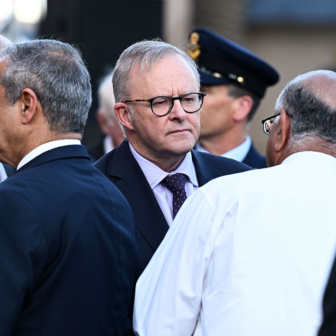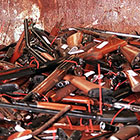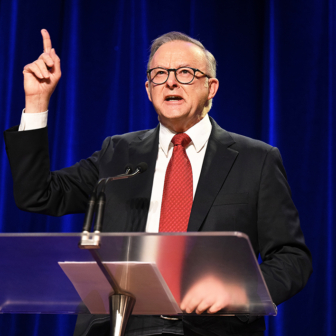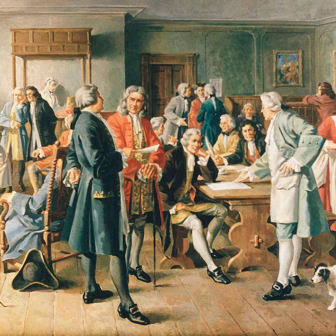While the Coalition was combusting over climate change and energy policy on Thursday, treasurer Jim Chalmers went to visit his alma mater, the Australian National University, to talk about opportunity.
He’d been asked to address Crawford School alumni on the campus where he wrote his PhD on Paul Keating and the use of prime ministerial power. The thesis of his eleven-minute address on Thursday evening was at least as interesting as the one for which he received his doctorate. Just how interesting depends on how you choose to interpret it.
Chalmers made an appeal to the bright minds there gathered. He urged them to join him in a mission to grab the opportunities now presenting themselves for Australia. He spoke of ambition and courage and leadership — of being here to “run the joint, not just occupy the space.”
He noted that big economic shifts in this country come around roughly every forty years. After the agricultural and colonial economy of the 1900s, the postwar economy of the late forties and the fifties — tariff-dependent and increasingly industrialised — and the 1980s’ opening to the world and growth in financial services, he argued we’re due for another one.
Pointedly, Chalmers observed that each shift “took leadership to land it.” What he called Australia’s “fourth economy” would not “build itself,” he added.
“It will take ambition and courage and it will take leadership to build a new economy powered by cleaner and cheaper energy and turbocharged by AI,” Chalmers told his audience in Canberra’s distinctive Shine Dome. “That’s why I want you all to understand that this a big moment for us as a country and we can’t talk ourselves out of it.”
What he said next bore flashes of familiarity, like the muted echo of another speech by another treasurer, given just a few kilometres away and thirty-five years ago. Not the same, mind, but approaching some similar territory.
“We can’t spend our time ambling slowly along the path of least resistance — not when the pace of change in the world is accelerating,” Chalmers said. “That path of least resistance leads to mediocrity and malaise. Instead we can make this a defining decade, filled with opportunity in a world of uncertainty. But only with your help. Only with your ideas. And only with your ambition.”
The vision of a continually modernising Australia, the warning of stagnation, the call to join the quest to avoid it. Now, where have we heard that before?
Way back in December 1990 another treasurer made an evening speech that dreamed of bold reform, spoke of the need for leadership and urged his audience to “come with” him. I remember that speech very well because I was there. I also remember the after-effects, which were seismic.
To be clear, Jim Chalmers’ Crawford School address is not Paul Keating’s Placido Domingo speech, not by a long shot. The circumstances, the audience and the tone are completely different and the impact will not be the same. The real leadership dramas, right now, are on the other side.
Keating was emotional and reflective that December night at the National Press Club when he addressed journalists from the federal parliamentary press gallery as guest speaker at their — our — annual dinner, having just attended the funeral of his Treasury secretary Chris Higgins. He had spent seven years as treasurer to prime minister Bob Hawke, who had won yet another term earlier that year. Keating was increasingly frustrated at being leader-in-waiting but Hawke was showing no sign of going anywhere.
What we didn’t know that night, and didn’t become public until the following year, was that Hawke had made a secret pledge two years earlier that if he won again in 1990, he would step down in Keating’s favour soon after. Nine months on from the election, he’d made Keating deputy prime minister but remained in the Lodge.
Keating’s speech was unmissably aimed at Hawke. He said Australia had “never had a great leader,” derided the kind of campaigning that involved “tripping over” television cords in shopping malls, and described himself as the “Placido Domingo” of Australian politics, from whence the speech would gain its forever label.
Supposedly off the record, the Friday night speech was in a newspaper by Sunday. The events that followed have been canvassed ad nauseum — an enraged Hawke declared the speech treacherous and told Keating the still-secret leadership deal was off. Then, in June 1991, the existence of the verbal undertaking, which had been struck during a private 1988 meeting at the prime minister’s Sydney residence and became known as the “Kirribilli agreement,” was leaked to the Nine Network’s political editor Laurie Oakes. As intended, the leak precipitated a leadership challenge. Keating lost but challenged again in December that year and prevailed, going on to win the 1993 election against expectations.
In this week’s speech, by contrast, Jim Chalmers made no criticisms of the government or his prime minister, who is riding high after a second and extraordinarily decisive election victory. There’s no secret handover deal and Chalmers isn’t the heir apparent, just the most prominent in a queue of aspirants whose hopeful timelines have all now been extended to the horizon.
And Chalmers’ Crawford School address was broader in scope and looking to the positive — to the opportunity that lies in ambitious policy, which he called the “protein” of government, as opposed to the “carbohydrates,” politics.
But in the warning about paths of least resistance delivering “mediocrity and malaise” there seemed just a hint of the kind of frustration you might see in someone who wants to go big when others around — or above — them are more wary.
Chalmers can argue he’s not talking about his own side and point legitimately to an opposition in flames and reheating old climate scepticism — a Coalition he believes would drag Australia backwards and let the opportunities the world is presenting pass the nation by.
He did mention Keating, though, via an old story he’s told before, including in another motivational speech he gave in 2022, that one to Treasury officials as they worked on his first budget. The story is about Keating as a young MP in the Old Parliament House during the Whitlam government, bumping into then treasurer Jim Cairns in the men’s room. Cairns was wearing a Vietnam moratorium badge and asked Keating why he wasn’t doing the same.
“And Paul says to Jim Cairns something like: ‘The difference between me and you, mate, is you came here to protest. I came here to run the joint,’” Chalmers recounted. Context is everything, and the story rang differently somehow in this week’s speech, maybe because of Chalmers’ recent tensions with Anthony Albanese over superannuation policy and recent consultations with Keating himself. Chalmers went on to borrow the key phrase as he reflected on having spoken the other day to a group of young graduate students now working in his Treasury.
“Their questions that afternoon reflected a level of ambition that we don’t always see in our politics, and I think to our detriment,” Chalmers said. “They’re here, and we’re here, to run the joint. And what a time to run it.”
And in encouraging his Crawford School alumni audience to use their knowledge and passion to help reshape the economy and build the future, he reflected on the Albanese government’s achievements thus far, declaring it had “made the right calls and the big calls for the right reasons, well-intentioned and well-informed.”
“I think that’s the test for all of you and it’s the test for all of us in your line of work and in mine — to actually run the joint, not just occupy the space,” he said, in conclusion. “To do justice to the opportunity that the world is dangling in front of us, and the opportunity that this country and this university has given us.”
Like I said, an interesting speech. •




